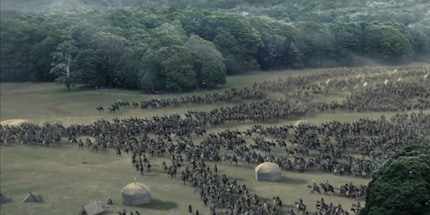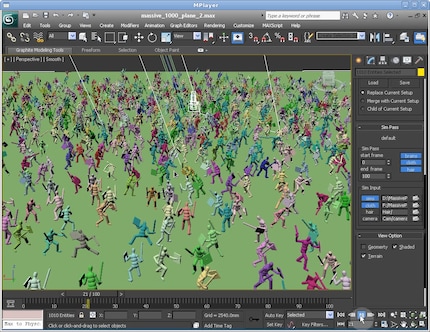
And cut! Brave Lord of the Rings warriors running away in their thousands
You think only screenwriters know how to write good stories? Fiddlesticks! This article is about curiosities, funny anecdotes and all sorts of wacky things in cinema and filmmaking. My first example: «The Lord of the Rings» CGI warriors on strike.
Rohan’s entire army – they’re called «Rohirrim», People of the Horse-lords – gathers on the Pelennor Fields. A 6,000-strong cavalry army, led by the proud King Théoden, is facing almost certain death. Their odds of victory are slim. Gondor, one of the last free cities of the people of Middle-earth, is besieged by no fewer than 200,000 Orcs.
«Arise, arise, Riders of Théodens,» the king calls out one last time to his army, «Ride! Ride for ruin – and the world’s ending. Death!»
The proud warriors echo this call, encouraged by their king, but well aware that this will be their end.
«Death! «Death! «Death!»
The sound of a horn is heard and the army moves forward. Slowly at first, like a mighty machinery that hasn't been used for too long. And then the six thousand horses pick up speed. This will be the last act of the riders of Rohan...
..but one hell of an act.
Hundreds of thousands of soldiers and evil creatures storming towards and waging war against each other? This was unimaginable fifteen years ago, when «The Lord of the Rings» was released. Or at least an eye opener, to say it with Samwise Gamgee‘s words. So it’s unsurprising that not everything went according to plan right from the start, when the mighty armies were created.
Nevertheless, the anecdote involving terrorised CGI soldiers fleeing the battlefield unintentionally and apparently full of horror is curious.
Massive: The ground-breaking computer software
The armies were created on the computer by the New Zealand visual effects company Weta Digital. Makes sense – coordinating a huge cavalry army and an enormous number of grunting orcs must be a logistical nightmare. And a dangerous one, too. But there was no software in those days that could create such computer effects in a realistic way. There was pioneering work to be done. The outcome? The software «Massive».

Massive is based on a simple concept: Computer-animated 3D models, so-called agents, are given a common goal and – at the same time – decide independently how this goal is achieved. This might sound a bit like artificial intelligence, but it's not.
The system operates with stimuli and subsequent reactions. If a certain stimulus occurs, the agent is offered a range of reaction options, from which it selects one. Let's take a look at an example: If an attack occurs, the reaction is «dodge». Every possible reaction has a certain probability. In the case of an attack, the defence strategy is more likely to be «dodge» than «run in circles and do somersaults» because the former makes more sense and therefore has a higher priority.
If more than 200,000 agents enter a battle, a less probable behaviour may occur in isolated cases, provided that this behaviour is programmed as a possible reaction. Thus, an army of Massive agents never behaves exactly the same – but the overall behaviour is still logical.
CGI soldiers trying to get away
In theory, the agents should know what to do now. They really should. Let’s get the battle started then. At least that's what the team of programmers, lead by Stephen Regelous thought when they ran their first tests. In a «Lord of the Rings» making-of, Regelous explains:
«We started off by battling 1,000 silver soldiers against 1,000 gold soldiers. So we launched the simulation and were excited to see what was going to happen. That's when something unexpected occurred: A group of several hundred soldiers tried to run for the hills in the distance.»

Source: billdesowitz.com
What on earth? Fear, panic, or possibly even desertion?
At first, the developers weren't quite sure what had gone wrong. Did they really develop agents that were so clever they realised joining the fight would be sheer madness? As if they were thinking: «F**k this sh*t, I’m out.»
«Would have made for a great story, but no,» Regelous states in the making-of, «the little bastards [that's what he calls the agents] follow pre-programmed reactions. Self-preservation isn't one of them.»
So why did they try to flee the scene?
It took quite a few more tests for the developers to find the answer to this question. The origin of the problem was in the two following instructions programmed into the agents:
- search for more space if you're in a crowd
- run until you find an enemy to fight with
So: Two huge armies of agents storm towards each other until they meet the enemy. That’s when the space gets limited. Some agents look around for a less crowded place and – sure enough – find exactly this in the opposite direction. So they run in that direction and, as they don't meet any enemy, never stop. Another instruction also favoured this desertion of the army:
- If in doubt, follow your friends
That’s what made them look as if they were thinking «Right, if he's legging it, so am I.»
What next? The problem was solved by adjusting the priority of instructions. As easy as that. Now you know the story of how fearless «Lord of the Rings» warriors seemed to be absolutely terrorised and tried to escape the battle – although they actually did nothing else other than follow orders.
Know of any absurd stories or funny anecdotes from cinema or filmmaking? Write a comment or send me an e-mail. I might tell your story in the next episode of my «And cut!» series.
I write about technology as if it were cinema, and about films as if they were real life. Between bits and blockbusters, I’m after stories that move people, not just generate clicks. And yes – sometimes I listen to film scores louder than I probably should.
Interesting facts about products, behind-the-scenes looks at manufacturers and deep-dives on interesting people.
Show all